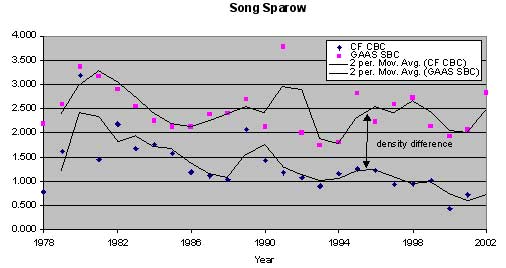    |
 |
|
by Dwight Chasar The Greater Akron Audubon Society Summit Co summer bird counts (GAASSBC) and the Cuyahoga Falls Christmas bird counts (CBC) substantially census the same area of the county. In past articles I compared the last 25 years of data from the two censuses for population trends for some year-round resident birds. The trend data agreed well for Red-bellied Woodpecker (Chasar 2003a) whose population has been growing rapidly and for eight other common resident birds (Chasar 2003b) whose populations appear to be relatively constant. For all these birds the CBC showed a higher density (birds/party hour) than the SBC and possible reasons for this were addressed. Although the Song Sparrow (Melospiza melodia) is classified as a permanent resident in Ohio, it undergoes a definite migration in the spring and fall, where the last fall lakefront migrants depart by mid-November (Peterjohn 2001). To complicate the issue, it was estimated that approximately 50% of the wintering population around Columbus were visitors from north of Ohio (Nice 1937). Without question the "Silver-tongue" (Dawson 1903) could be the ultimate test species for which to compare population trends between the two counts. When I look at population trend data I use various methods to see how they compare or how the trends can best be presented. Sometimes a straight trend line or a smoothed curve can be more demonstrative. For the Song Sparrow I used a two-year moving average to compare the data. In a two-year moving average, the density (birds/party hr) is averaged for year one and two, for two and three, for three and four, and so on. This method tends to smooth out the year to year fluctuations and can sometimes better reveal subtle changes in a trend. The accompanying graph shows plots of song sparrow density vs. year using the two-year moving average for each of the two different county censuses. It is clear that the density is highest for the summer bird count, contrary to that found for the other resident birds discussed earlier.  This is logical since many song sparrows migrate out of the area for the winter. More interestingly, however, is that the two trend lines tend to fluctuate up and down in nearly a parallel fashion. A change in density as a result of some factor that increases or decreases the population can be observed in both counts. When I looked at the straight-line trend for both sets of data, both were slightly down, contrary to the state-wide Breeding Bird Survey (Earnst 1996) which indicates a slight overall increase. It would appear that the two censuses in Summit Co are very consistent with one another.
Chasar, D. 2003a. Cleveland Bird Calendar. 99(1):13. Chasar, D. 2003b. Cleveland Bird Calendar. 99(2): 33. Dawson,W.L. 1903. The Birds of Ohio. The Wheaton Publ. Co.,Columbus, OH. Earnst, S.L. and Andres, B.A. 1996). Population Trends of Breeding Birds of Ohio. The Ohio State University, Columbus. OH. p. 103. Nice, M.M. 1937. Studies of the Life History of the Song Sparrow. Vol. 1. Trans. Linnaean Soc. New York, Vol. 4. 246pp. Peterjohn, B.G. 2001. The Birds of Ohio. The Wooster Book Co, Wooster, OH. Top of Page Back to Bird Watching |
 |
|
|

